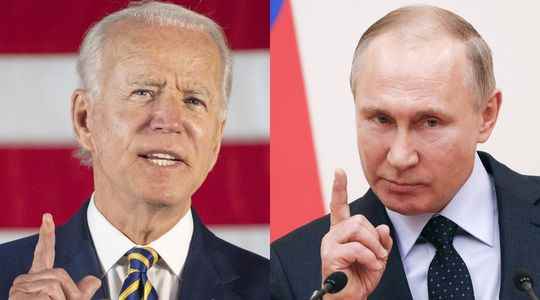Wednesday February 16 was finally a day almost like the others for the Ukrainians. True, their ministries and biggest banks have suffered a massive cyberattack, the largest in months, and their country remains surrounded by some 150,000 Russian troops. But, contrary to what American intelligence had been agitating for days, this Wednesday was not the day of an invasion by the Red Army. “The signal is encouraging, but given the scale of the Russian forces deployed, everything is still possible, asks a French diplomat. Let’s not analyze too much and remain cautious.”
For months, Russia has been blowing cold and very cold around Ukraine. For no apparent reason, the Kremlin massed tens of thousands of troops near the country’s northern borders in November, before encircling the region and launching unprecedented military exercises. But, as the West thought an attack was imminent, Moscow said on Tuesday its troops were returning home “as planned, obviously”.
Putin’s “beautiful promises” contradicted by NATO
This information blizzard is worthy of the darkest maneuvers of the KGB and its former agent, Vladimir Putin. By hiding his intentions and multiplying the threats, he manages to worry and disconcert the adversary, without even taking action. “All that matters for the Kremlin is to have a reaction from Washington, believes Mathieu Boulègue, researcher specializing in Eurasia at Chatham House in London. Of course, Putin can make great promises. But the only thing to watch is the movements of his troops.” Two days after the announcement of the Russian withdrawal, NATO ensures that the Kremlin has actually sent 7,000 additional men near the Ukrainian borders…
Faced with this great Russian fog, the United States opted for a new technique: revealing all their information to the press, even if it meant falling into alarmism. “We have the same information as the Americans and the same assessment of the risk of attack, but not the same communication strategy”, summarizes an adviser to the Elysée. The Anglo-Saxon media are full of “American intelligence sources” describing in detail the next movements of the Russians, from the precise date of the invasion (this February 16, therefore…) to its justification by the Kremlin (a fake video Ukrainian drone attack).
This alarmist strategy is assumed and even praised by the Biden administration, which wants to take Russian disinformation at its own game, after years of suffering it. Secretary of State Antony Blinken admitted this bluntly in an interview, in French, to France 24 “People need to understand the tools that the Russians, in the past and today, put at their service, including the creation of false provocations, to justify an intervention that was well planned before. done in their logic and shedding light on that may be a way to avoid it.”
Moscow takes control of communication
But this Anglo-Saxon alarmism, which flirts with disinformation, is difficult to sustain, while confidence in Western authorities is at its lowest. How do you continue to believe US intelligence that details a non-existent Russian invasion? The Kremlin, initially surprised by the White House offensive, is trying to regain control of the narrative around Ukraine.
Since Monday, Moscow has mocked the “hysteria” of Westerners and broadcast its astonishment in all the media. First by a mind-blowing video in which Putin and his minister Sergei Lavrov discuss the benefits of diplomacy, then by press releases denouncing “belligerent propaganda” from the West.
It is then the Russian ambassadors, in a perfectly ordered communication broom, who spread through Western newspapers to denounce the panic of the Americans and Europeans. So, Vladimir Chizhov, Moscow’s ambassador to the European Union, in the German newspaper Die Welt “When you make such serious accusations against Russia, you have a responsibility to present evidence. […] So where is the evidence?” Twenty years later, US lies to justify the war in Iraq are still playing into Moscow’s hands.
The White House’s zeal is also turning against the Ukrainian authorities, openly annoyed by a strategy that is paralyzing their country. Traumatized by the debacle of the departure from Afghanistan last summer, Washington evacuated its embassy and its nationals first, before being followed by the majority of its allies, from the Israelis to the Dutch via the Japanese. “The best friend of our enemies is panic, got carried away the Ukrainian president, Volodymyr Zelensky. All this information [sur l’imminence d’une invasion] only cause panic and do not help us.”
While the war remains only a hypothesis, the Ukrainians are already its first victims.
